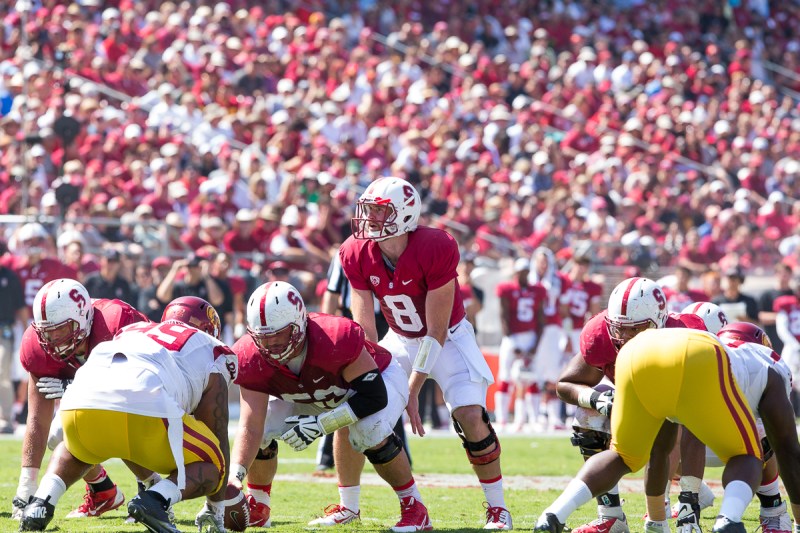45.5 percent: To say that Stanford’s performance in the red zone on Saturday against USC was disastrous would be nothing short of an understatement. Now, through the team’s first two games, the Card rank 125th out of 127 FBS teams in red-zone scoring efficiency, having scored on just five of 11 (45.5 percent) attempts inside their opponents’ 20-yard line — just three of those 11 drives have resulted in touchdowns.
Contrast that with the Cardinal’s red-zone performance at home last season: 29-for-29 in scoring chances, a 100 percent rate that was unmatched in the country.
It seems to be a continuation of a disturbing trend for Stanford football, whose fans have seen the precipitous decline of the team’s red-zone efficiency since Andrew Luck’s senior season, also the first year of head coach David Shaw’s tenure.
| Stanford’s Red-Zone Efficiency: Year-by-Year | ||
| TD Percentage | National Rank | |
| 2011 | 76.1 | 4th |
| 2013 | 60.8 | 76th |
| 2013 | 57.7 | 83rd |
| 2014 | 27.3 | 121st |
Before I go any further, yes, this year’s numbers are through just two games. And yes, you can easily argue that the Cardinal’s offense well outperformed that of the Trojans this past Saturday — just look at total yards: Stanford outgained USC, 413 to 291. But it goes without saying, if you reach the opponents’ 32-yard line on each offensive drive, you have to put more than 10 points on the board. Hopefully, going up against a different defense will help…

554: If the Cardinal wanted to go up against any defense in the country following their aforementioned red zone disaster last Saturday, Army’s might have been on their short list. In the Black Knights’ season-opening win over Buffalo last Saturday, their defense allowed 39 points and 554 total yards. Buffalo converted five of six red-zone opportunities for scores in the game, four for touchdowns.
It’s safe to that Army’s defense is long removed from its legendary post-war days from 1944-1946, when the team allowed fewer than six points per game over a three-year span, winning three straight national championships.
Last season, the Black Knights’ defense ranked 91st of 125 FBS teams in opponents’ red zone efficiency, allowing 44 scores in 51 opportunities (86.3 percent). That’s a huge difference from USC’s red-zone defense, which was the best in the nation last season, as their opponents converted just 62.8 percent (27 of 43) of their red zone tries.
189: Over Stanford’s first two games, new defensive backs coach Duane Akina’s squad has been one of the best-performing units of the team. The Cardinal defense has allowed just 189 yards through the air thus far this season, and their 94.5 yards per game average ranks seventh in the country.
Stanford’s secondary held USC quarterback Cody Kessler to just 135 passing yards on Saturday, just one week removed from his 394-yard, four-touchdown performance against Fresno State that had pundits already singing his praises.
However, Army had just seven pass attempts to 54 rush attempts in their season opener, so while Stanford’s defensive backs will likely shut down the Black Knights’ aerial attack, they will likely not be too busy on Saturday.
11: When it comes down to it, the Cardinal hope to get their run at the inaugural College Football Playoff back on track after a tough loss. History will be on the team’s side, as they are undefeated over their last 11 home games against unranked opponents — their last loss was to an unranked Notre Dame squad in November 2007.
Kickoff on Saturday against the Army Black Knights is set for 2 p.m., and the game will be televised on Pac-12 Networks.
Contact Jordan Wallach at jwallach ‘at’ stanford.edu.
